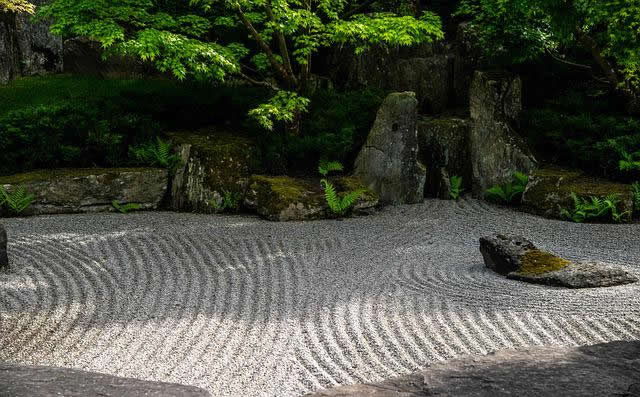先日から「The meaning behind the Japanese Zen garden -「日本の禅庭に込められた意味」を読んでいます。

・「日本の禅庭に込められた意味」(1)
・「日本の禅庭に込められた意味」(2)
It may seem strange that fierce warriors should also be into tea and gardening.
猛々しい武士がお茶や園芸をたしなむのは不思議な気もする。
But as Trevor Legget wrote in the book Introduction to Zen Training (Tuttle):
だがトレバー・レジェットは「禅の修行入門」の中で次のように書いている、
“Many warriors were men of culture, poets and artists, with their work often illuminated by their Zen training.”
「武士には文化人、詩人、芸術家が多く、その作品には禅の修行が生かされていることが多い。」
Zen isn’t just sitting cross-legged and meditating (which is zazen, or seated meditation).
禅とは、ただあぐらをかいて瞑想すること(それは座禅)ではない。
All manner of activities, from sweeping the garden and chopping vegetables, to the tea ceremony, ikebana (flower arrangement), and landscape gardening are all considered practices of Zen discipline, aimed at focussing the mind and working toward spiritual awakening.
庭掃除から野菜の下ごしらえ、茶道、生け花、造園など、あらゆる行為が禅の修行とされ、それらによって精神の集中と覚醒を目指すものだ。
Japan’s leading contemporary Zen garden designer, Masuno Shunmyo, an 18th-generation Zen priest, explains this connection between Zen and the arts:
現代日本を代表する禅の庭園デザイナーである枡野俊明氏(禅僧18世)は、禅と芸術の関わりについてこう語る、
ascetic「苦行の、禁欲的な、禁欲生活の、行者のような」。
“Through Zen ascetic practice, an emotion of the mind is found that can’t be directly exposed or understood.
「禁欲的な禅の修行を通して、直接的に露出したり理解したりすることが出来ない心の感情が発見されます。
One must therefore discover ways to communicate this emotion to others.
そのため、この感情を相手に伝える方法を見つけなければなりません。
That is, ‘the expression of oneself’.
つまり『自分を表現すること』。
The Zen priest has traditionally turned to such classical arts as calligraphy, ikebana and rock placement.”
禅僧は伝統的に書道、生け花、石庭などの古典芸術に傾倒してきました。」
昔の命がけの戦いをしていた武士たちは、禅を通して自分の内面を見つめることで、心の平穏や迷わない強さを身に着けようとしていたのかな、という気がしました。
理由は単純明快!「少ないコストでしっかり楽しく学べるから」。
私自身の経験(高機能でビックリ)をびっしり書いていますので、良かったら読んでみてください。
下のバナーからどうぞ!






